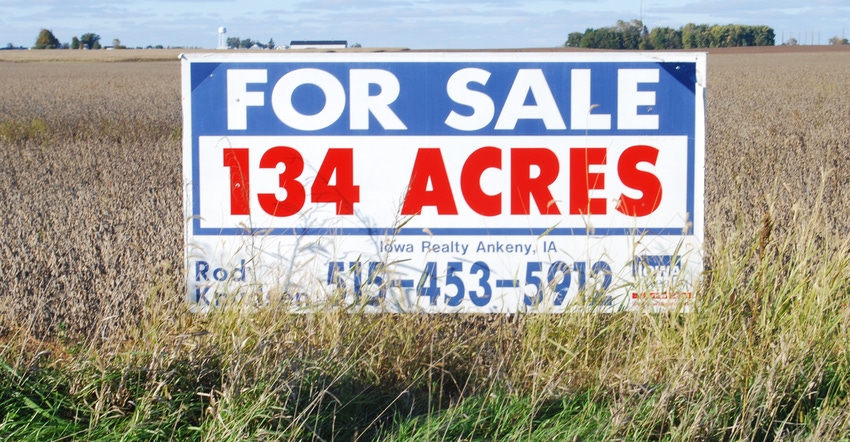December 27, 2018

As we enter 2019, it’s worth looking back over the 2018 crop year one last time. This past year had its share of challenges, including significant springtime snow in April that delayed planting season, too much rain in June, too little rain in July and too much rain again in October that delayed harvest season.
We also had rising interest rates, lots of trade conflicts, weakening commodity prices and several damage-inflicting tornadoes thrown in between all this other action. Despite the challenges, strong corn and soybean yields in 2018 carried the majority of farming operations through another crop year, with most producers now having high expectations for what’s to come in 2019.
Despite last year’s challenges, the farmland market in recent months has shown surprising resiliency and stability throughout Iowa. Localized differences in crop yields played a role in land sale results this past fall, particularly in areas where another big crop was produced.
Essentially, these big production areas “out-busheled” the weakness in crop prices. However, in local areas where yields were average or below-average, there was a more noticeable softness to the land market. Regardless of the area, high-quality farms with the most productive soils, solid drainage, easy farmability and strong fertility continue to sell best. And despite some of the negative factors in the land market, farmers continue to pursue acquisition opportunities when they make sense to the core operation of their business.
Factors influencing land prices
A small handful of issues continue to influence the Iowa farmland market. First, last year’s crop production plays a role in current land sales. Typically, the more bushels grown in an area, the more competitive most land sales in that area prove to be.
Second, increasing interest rates will continue to pressure farmland values. The Federal Reserve again raised short-term rates at their December meeting, which follows a consistent pattern of bumping short-term rates since late 2016.
While short-term rates don’t directly impact long-term borrowing costs, short-term rates directly impact farm operating notes, which are now squarely in focus, as we are in operating loan renewal season. And since early fall of 2018, long-term rates have also increased to multiyear highs.
Third, disruption in the commodity markets by the enactment of global trade tariffs is real and has softened U.S. grain markets. Coming away from the G-20 Summit in Argentina, there was some expectation that cooler heads were going to prevail, and that stability may return to the global marketplace, particularly as it relates to the U.S. and China. Ultimately, how global trade negotiations play out in weeks and months ahead will continue to impact commodity prices, market confidence and underlying asset values including farmland.
Fourth, as we approach the 2019 growing season, there will be a reset in crop insurance price levels for 2019. Where these revenue policy price levels will reset for 2019 production is important to producers. Finally, details of the new farm bill policies will impact the countryside for the next several years. Stay tuned for further analysis as new information surfaces on all these topics.
NORTHWEST
Buena Vista County: Northwest of Albert City, 80 acres recently sold at public auction for $8,500 per acre. The farm consists of 79 tillable acres with an 86.5 CSR2 and equals $99 per CSR2 point on the tillable acres.
NORTH CENTRAL
Winnebago County: Located near Woden, 160 acres sold at public auction for $8,800 per acre. The farm has 152 tillable acres with an 80.5 CSR2 and equals $115 per CSR2 point on the tillable acres. This farm also includes 20,000 bushels of grain storage, a 36-foot by 40-foot machine shed, a steel Quonset building and a small storage shed.
NORTHEAST
Black Hawk County: South of Jesup, 39 acres sold at public auction for $7,200 per acre. The farm consists of 38 tillable acres with a 76.8 CSR2 and equals $96 per CSR2 point on the tillable acres.
WEST CENTRAL
Woodbury County: East of Anthon, 80 acres recently sold at public auction for $6,650 per acre. The farm consists of 76 tillable acres with a 72.3 CSR2. The sale equals $97 per CSR2 point on the tillable acres.
CENTRAL
Boone County: Northeast of Madrid, 120 acres sold at public auction for $8,650 per acre. The farm has of 116 tillable acres with an 83.8 CSR2. The sale equals $107 per CSR2 point on the tillable acres.
EAST CENTRAL
Cedar County: Northeast of Tipton, 80 acres sold for $7,900 per acre. The farm has 78 tillable acres with a 79 CSR2. Sale equals $102 per CSR2 point on the tillable acres.
SOUTHWEST
Taylor County: South of Clearfield, 169 acres recently sold at public auction for $4,950 per acre. The farm consists of 147 tillable acres with a 71.1 CSR2. The sale equals $80 per CSR2 point on the tillable acres.
SOUTH CENTRAL
Madison County: Northeast of Macksburg, 122 acres sold for $5,049 per acre. The farm has 95 tillable acres with a 65.1 CSR2. The remaining acres are timber draws and waste. The sale equals $99 per CSR2 point on tillable acres.
SOUTHEAST
Keokuk County: North of Keota, 40 acres sold at public auction for $7,750 per acre. The farm consists of 40 tillable acres with a 61.6 CSR2, of which all the tillable acres are in CRP until 2020 with an annual payment of $7,344. The sale equals $125 per CSR2 point on the tillable acres.
Hertz Real Estate Services compiled this list, but not all sales were handled by Hertz. Call Hertz at 800-593-5263 or visit hertz.ag.
You May Also Like




